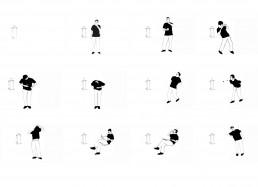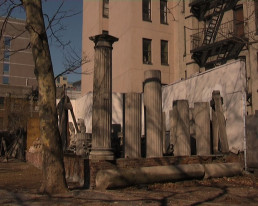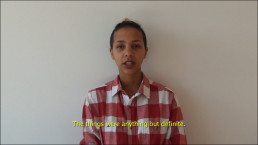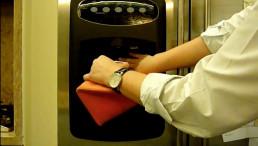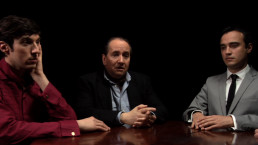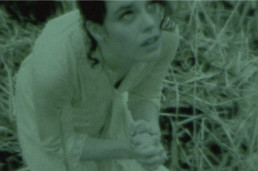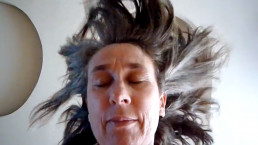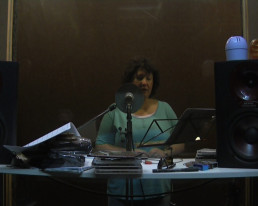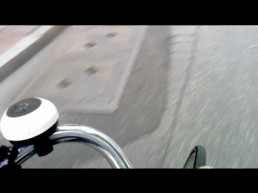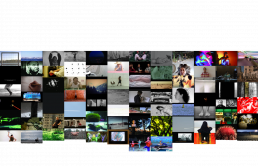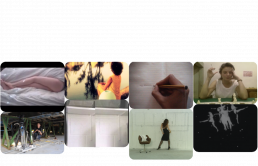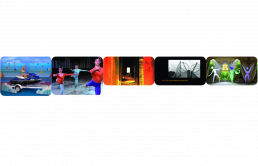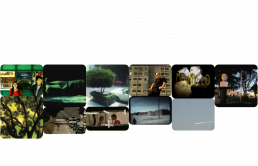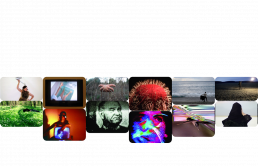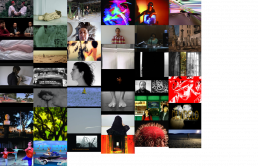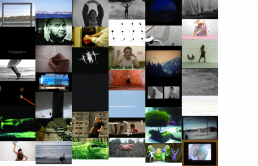“FUSO 2013 – 20 de Agosto a 20 de Setembro“
23 Agosto, 22h
Museu Nacional de Arte Contemporânea (MNAC) – Museu do Chiado
AFINIDADE, Um conto de 113 palavras de Lydia Davis
Curadoria de Susana Pomba
Duração da sessão 46′
Susana Gaudêncio, O Sanguíneo (A comédia dos Humores – O Sanguíneo, O Melancólico, O Colérico, O Fleumático), 5’, projeção monocanal, animação vídeo, DVD (PAL), stereo
Na animação O Sanguíneo, uma personagem imita um líder político em campanha eleitoral abordando uma audiência invisível. O Sanguíneo integra a instalação A Comédia dos Humores organizada como uma peça teatral, é composta por quatro personagens que interpretam cada um dos humores ou estereótipos desenvolvidos por Ben Jonson com base numa antiga teoria fisiológica da medicina, são eles o sanguíneo, o melancólico, o fleumático e o colérico. Estes humores oferecem caracteres físicos e psicológicos específicos às personagens. Por sua vez são os textos de alguns autores do Teatro do Absurdo, nomeadamente, Becket, Ionesco, Pinter ou Genet, que constroem os temas dos seus discursos e ações. Os guiões parodiam a natureza humana, que sofre a influência de uma sociedade cada vez mais mecanizada e hostil.
Pedro Barateiro, Texto Impossível (Impossible Text), 1’59’’, vídeo (MiniDV transferido para DVD), cor, som
Parte integrante do projeto Eighty-Two Poems que Pedro Barateiro apresentou na Bienal de Sidney de 2008, em que um novo vídeo era apresentado por cada dia da bienal. Estes “vídeo-poemas” são um projeto “ongoing” do autor, onde o texto (voz ou escrito) aparece como uma espécie de fio condutor entre as imagens. Texto Impossível utiliza um texto do artista sobre imagens filmadas em Nova Iorque.
Cortesia do artista e da Galeria Filomena Soares
Sara Amido, A Lot of Things, 2012, 5’35’’, vídeo, cor, som
A Lot of Things é sobre a versatilidade e a ambiguidade da linguagem, utilizando a palavra “thing” como exemplo primordial. Todas as diferentes palavras ouvidas nestes cinco excertos de texto, que são traduzidas nas legendas como “thing”, são de facto sinónimos dessa palavra retirados de um dicionário. Para ilustrar ainda melhor esta maleabilidade, as frases nestes textos foram todas retiradas de entradas de dicionários de sinónimos que exemplificam o uso da palavra. Como resultado, os textos tornam-se sobre “muitas coisas”.
Salomé Lamas, Rascunho – Pássaros para Old School #21, 2013, 11’48’’, vídeo HD, cor, som
Este Rascunho – Pássaros é um filme de Salomé Lamas iniciado no âmbito do projeto Old School #21, em Abril de 2013, que investiga, entre outras coisas, as atividades columbófilas na zona de Lisboa e na história de Portugal.
Produção Susana Pomba
Câmara Takashi Sugimoto
Agradecimentos Miguel Nabinho, Ana Vidigal, Francisco Moreira, Cristina Lamas, Margarida Lucas e Columbófilos do Prior Velho
Ana Vidigal, Summer of Sam(antha), 2010-13, 1’34’’, vídeo HD, cor, som
A artista Ana Vidigal, muito conhecida pela sua pintura e instalação, produz vídeos descomprometidamente, mas com muita regularidade, para o seu canal do Youtube “borracha verde”. Feito originalmente no Verão quente de 2010, Summer of Sam(antha) é um desses curtos vídeos.
Pedro Barateiro, Destruir a Escrita: J. Derrida (Destroying Writing: J. Derrida), 2008, 1’17’’, MiniDV transferido para DVD), cor, som
Parte integrante do projecto Eighty-Two Poems que Pedro Barateiro apresentou na Bienal de Sidney de 2008, em que um novo vídeo era apresentado por cada dia da bienal. Estes “vídeo-poemas” são um projeto “ongoing” do autor, onde o texto (voz ou escrito) aparece como uma espécie de fio condutor entre as imagens.
Cortesia do artista e da Galeria Filomena Soares
Vasco Araújo, Eco, 2008, 12’18’’, vídeo, cor, som
O vídeo baseia-se nas ideias de heterogenia e a relação psicológica do eu, como eu e o outro, eu e o meu pai, eu e a minha mãe. Os seis personagens (5 homens e 1 mulher) estarão a interagir uns com os outros através de um texto, que nos coloca questões do tipo, o que é que fazemos aqui ou o que fizemos do nosso destino. O texto baseia-se na obra de Cesare Pavese, Diálogos com Luéco.
Atores André Gomes, André E. Teodósio, Cláudia Jardim, Diogo Bento, Gustavo Boldt, Pedro Penim
Voz Vasco Araújo
Texto A partir de Diálogos com Luecó de Cesare Pavese
Gabriel Abrantes, Dear God Please Save Me, 2006, 3’14’’
“Aqui está uma mulher que carrega uma cápsula do tempo, que contém coisas que ela quer que Deus veja no futuro. A mulher está muito angustiada. É uma mulher intelectual da América Vitoriana. É também uma paleontologista. Deus vai ficar muito satisfeito com a sua cápsula do tempo. Ele está ansioso por abrir a caixa, como se fosse um presente embrulhado. A mulher é muito consciente do futuro, apesar de ser paleontologista. Sabe que Deus vai querer ver todas estas coisas velhas. A mulher está muito angustiada. Fez a cápsula do tempo e está a tentar enterrá-la para que Deus a veja no futuro. Está a rezar a Deus. Está a pedir a Deus para a salvar.”
Realização, Produção e Edição Gabriel Abrantes
Argumento Gabriel Abrantes e Alex Carver
Cinematografia e Assistência à criação Katie Widloski
Performance Kathryn Kerr
Voz James K. Wilkins e Kathryn Kerr
Ana Vidigal, Rabo-de-Cavalo, 2013, 2’25’’, vídeo HD, cor, sem som
Nova criação em vídeo da artista Ana Vidigal, muito conhecida pela sua pintura e instalação, aqui apresentada em estreia.
Pedro Barateiro, Ontem à Noite: Marguerite Duras (Yesterday Night: Marguerite Duras), 2008, 1’51’’, MiniDV transferido para DVD, cor, som
Parte integrante do projeto Eighty-Two Poems que Pedro Barateiro apresentou na Bienal de Sidney de 2008, em que um novo vídeo era apresentado por cada dia da bienal. Estes “vídeo-poemas” são um projeto “ongoing” do autor, onde o texto (voz ou escrito) aparece como uma espécie de fio condutor entre as imagens.
Cortesia do artista e da Galeria Filomena Soares
De Almeida e Silva, Pigeon, Peugeot, Pegeon, Peegeot, Pee gott, 2011, 1’17’’, vídeo de baixa resolução, cor, som
Na altura em que produzia este vídeo, De Almeida e Silva (D.A.E.S.) escrevinhava nos seus cadernos: “Que tipo de espaço de trabalho é que realmente preciso? Como a minha prática artística usa suportes muito variados, a necessidade varia entre um espaço aberto muito grande e nenhum espaço de todo. E aqui é que a dificuldade começa, um espaço não existente para um determinado trabalho precisa de ser não existente para que o trabalho não seja influenciado pela noção de espaço. De momento, o meu espaço ideal não seria um espaço real, mas a possibilidade de ter qualquer tipo de espaço para o trabalho que estou a fazer nesse momento.”
August 23, 11:15pm
Museu Nacional de Arte Contemporânea (MNAC) – Museu do Chiado
AFFINITY, A 113-word tale by Lydia Davis
Curatorship by Susana Pomba
Total running time 46′
Susana Gaudêncio, The Sanguine (The Comedy of Humours – The Sanguine, The Melancholic, The Choleric, The Phlegmatic), 5’, single-channel projection, video animation, DVD (PAL), stereo
In The Sanguine animation, a character mimics a political leader in an election campaign addressing an invisible audience. The Sanguine is part of The Comedy of Humours installation. Organized as a theatrical play, it consists of four characters who interpret each one of the moods or stereotypes developed by Ben Jonson based on an ancient physiological theory of medicine, they are the sanguine, melancholic, phlegmatic and choleric. These moods offer specific physical characters and psychological characters. On the other hand, they represent the texts of some authors of Teatro do Absurdo, namely, Becket, Ionesco, Pinter or Genet, who construct the themes of their speeches and actions. The scripts parody human nature, which is influenced by an increasingly mechanized and hostile society.
Pedro Barateiro, Texto Impossível (Impossible Text), 1’59’’, video (MiniDV transferred to DVD), colour, sound
Part of the Eighty-Two Poems project which Pedro Barateiro presented at the 2008 Sydney Biennial, in which a new video was presented for each day of the biennial. These “video-poems” are an “ongoing” project of the author, where the text (said or written) appears as a kind of guide between the images. Impossible Text uses the artist’s words about some images shot in New York.
Courtesy of the artist and Filomena Soares Gallery
Sara Amido, A Lot of Things, 2012, 5’35’’, video, colour, sound
A Lot of Things is about the versatility and ambiguity of language, using the word “thing” as a prime example. All the different words heard in these five text excerpts, which are translated in the subtitles as “thing”, are in fact synonyms of this word taken from a dictionary. To further illustrate this malleability, the phrases in these texts were all taken from entries in thesaurus dictionaries which exemplify the use of the word. As a result, the texts become “many things”.
Salomé Lamas, Rascunho – Pássaros para Old School #21, 2013, 11’48’’, HD video, colour, sound
This Rascunho – Pássaros is a film by Salomé Lamas initiated under the project Old School #21 in April 2013, which investigates, among other things, the activities in Lisbon and the history of Portugal.
Production Susana Pomba
Camera Takashi Sugimoto
Acknowledgements Miguel Nabinho, Ana Vidigal, Francisco Moreira, Cristina Lamas, Margarida Lucas and Columbófilos do Prior Velho
Ana Vidigal, Summer of Sam(antha), 2010-13, 1’34’’, HD video, colour, sound
The artist Ana Vidigal, well known for her painting and installation, produces videos uncompromisingly but regularly, for her “borracha verde” Youtube channel. Originally made in the hot summer of 2010, Summer of Sam(antha) is one of those short videos.
Pedro Barateiro, Destruir a Escrita: J. Derrida (Destroying Writing: J. Derrida), 2008, 1’17’’, MiniDV transferred to DVD), colour, sound
Part of the Eighty-Two Poems project which Pedro Barateiro presented at the 2008 Sydney Biennial, in which a new video was presented for each day of the biennial. These “video-poems” are an “ongoing” project of the author, where the text (said or written) appears as a kind of guide between the images. Impossible Text uses the artist’s words about some images shot in New York.
Courtesy of the artist and Filomena Soares Gallery
Vasco Araújo, Eco, 2008, 12’18’’, video, colour, sound
The video is based on the ideas of heterogeneity and the psychological relationship of the self, as myself and the other, myself and my father, myself and my mother. The six characters (5 men and 1 woman) will be interacting with each other through a text, which asks us some questions: what we do here or what we did of our destiny. The text is based on the work of Cesare Pavese, Dialogues with Luéco.
Cast André Gomes, André E. Teodósio, Cláudia Jardim, Diogo Bento, Gustavo Boldt, Pedro Penim
Voice-over Vasco Araújo
Text Based on Dialogues with Luéco by Cesare Pavese
Gabriel Abrantes, Dear God Please Save Me, 2006, 3’14’’
“Here is a woman who carries a time capsule containing things she wants God to see in the future. The woman is very distressed. She is an intellectual woman of Victorian America. She is also a paleontologist. God will be very pleased with her time capsule. He is eager to open the box, as if it was a wrapped gift. The woman is very conscious about the future, despite being a paleontologist. She knows God will want to see all these old things. The woman is very distressed. She made this time capsule and she’s trying to bury it so God can see it in the future. She is praying to God. She is asking God to save her.”
Directing, Production and Editing Gabriel Abrantes
Script Gabriel Abrantes and Alex Carver
Cinematography and Conceptual assistance Katie Widloski
Performance Kathryn Kerr
Voice-over James K. Wilkins and Kathryn Kerr
Ana Vidigal, Rabo-de-Cavalo, 2013, 2’25’’, HD video, colour, silent
A new video creation by the artist Ana Vidigal, well known for her painting and installation, here premiering
Pedro Barateiro, Ontem à Noite: Marguerite Duras (Yesterday Night: Marguerite Duras), 2008, 1’51’’, MiniDV transferred to DVD, colour, sound
Part of the Eighty-Two Poems project which Pedro Barateiro presented at the 2008 Sydney Biennial, in which a new video was presented for each day of the biennial. These “video-poems” are an “ongoing” project of the author, where the text (said or written) appears as a kind of guide between the images. Impossible Text uses the artist’s words about some images shot in New York.
Courtesy of the artist and Filomena Soares Gallery
De Almeida e Silva, Pigeon, Peugeot, Pegeon, Peegeot, Pee gott, 2011, 1’17’’, low resolution video, colour, sound
While producing this video, De Almeida e Silva (D.A.E.S.) wrote in his notebooks: “What kind of workspace do I really need? Since my artistic practice uses many different supports, the need varies between a very large open space and no space at all. And here is where the struggle begins, a non-existent space for a particular artwork needs to be non-existent so the artwork is not influenced by the notion of space. At this time, my ideal space would not be a real space, but the possibility of having any kind of space for the work that I am doing at that moment.”
